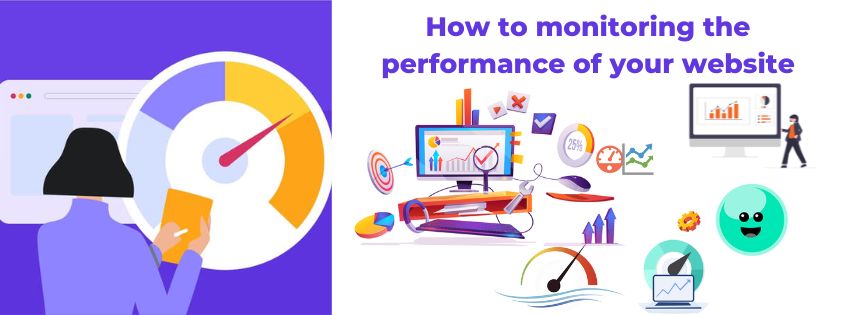
Jully 18, 2022
How to monitoring the performance of your website?
Monitoring website performance is an evolving paradigm primarily because website performance is synonymous with business. It goes beyond the typical measurement of web services and the ability of features to respond efficiently to end users In addition, market demands – the underlying technologies, use cases, issues, and risks – accelerate its growth.
Now we will know How to monitoring the performance of your website?
Web Performance Monitoring
Web performance monitoring refers to the set of practices and tools that help you monitor your web application using various metrics and technical parameters that affect page load speed and user experience. Most web performance analyzers help you check website status or uptime and track important metrics like page size, first-byte time, broken links, database performance, CPU usage, and more. By regularly monitoring your web applications, you can identify any chronic, hidden, or cyclical problems and be better prepared to deal with unexpected spikes.
The top Factor is Web Performance
Server location
Businesses spanning multiple geographies need to ensure that website functionality remains consistent across regions. However, if your website is hosted in one region (eg, Los Angeles), but receives traffic from another region (eg, Europe, Asia), the user experience will be different across these regions. In other words, the same page may load faster in the United States than in Europe. In such cases, you might consider implementing a CDN (Content Delivery Network). A CDN is a network of additional server nodes spread around the world to ensure faster response times and lower latency.
Server performance
A web server’s performance directly affects your website’s performance. Every time a browser pings your server, it requests the server to load or send some data to your website. If your server is unhealthy, it takes longer to process these requests. In most cases, your hosting provider is responsible for maintaining the servers. If your website uses shared hosting and regularly faces resource issues, you may consider switching ISPs or opting for a higher plan with more CPU, RAM, and disk space. If you have a self-hosted setup, you may want to check out this guide for monitoring web servers.
Code-associated troubles
Each big website is made from thousands of lines of CSS, HTML, and JavaScript code. As websites evolve, so do the density and complexity of code. Occasionally multiple scripts are going for walks in parallel. In such situations, net server calls may be delayed longer than anticipated. Additionally, multiple threads gaining access to the same shared code or files can motivate “race conditions”, which can make a website at risk of protection threats.
If the third celebration service stories an outage or expanded load, it’s going to take longer to meet your internet site requests. Following utility improvement first-class practices (eg, minification of JavaScript, CSS, and HTML documents, browser caching, and so on.) and ensuring that each script is well optimized for speed and security will assist you to keep away from such issues.
Page Size
The ubiquitous availability of high-speed broadband and 4G mobile networks has made it possible for businesses to deliver better customer experiences using rich multimedia content. Most consumer-facing websites include high-resolution images today. As a result, the average physical size of web pages has increased as well. But if the page weight increases it may take longer to load. To ensure that your website pages load quickly, all images and elements should be optimized or compressed wherever possible. In addition to compression, there are other techniques to optimize page size.
Malfunctioning CMS plugin
One of the advantages of using a content management system (CMS) is that they offer numerous plugins, which prevent your development team from reinventing the wheel. While these plugins save significant time and effort on coding, they can also introduce myriad performance and integration-related challenges. Plugins built with outdated technology or inefficient database queries can have high load times. Further, free plugins are rarely updated and may contain vulnerabilities without patches. Development teams should consider limiting the use of plugins to the bare minimum.
Some types of web performance monitoring
As mentioned, monitoring website performance is an evolving field. It is always related to the type of service provided. There is a wide range of free and affordable application monitoring tools for an organization to choose from
Various solutions offer different levels of monitoring granularity, such as active and passive monitoring. Similar to Retrace from StackFi, it can monitor everything with active app monitoring and passive real-user monitoring methods.
Monitoring synthetic performance
A tool for monitoring synthetic performance is Netrio’s Web Application Response Time (Web art). WebART Check monitors the availability and performance of a single, web-based application. These checks are generally useful for monitoring the performance and usability of traversal paths that users of that application may take.
Typically, these tools generate reports and alerts based on the performance of the site during performance checking. The synthetic check is the user’s simulated path step. WebART synthetic checks are added and configured to mimic a given path that an end-user might take through your application. This route is monitored for performance by measuring aspects such as performance, availability, and response time.
Basic web performance monitoring
Basic website performance indicators identify certain back-end issues, such as tracking uptime and other performance trends. Although it is not as efficient as advanced equipment.
A business can choose performance monitoring tools from basic to advanced based on its needs. For example, a brochure site with non-critical pages may opt for the most basic form. These tools primarily focus on HTTP and HTTPS monitoring or monitoring uptime.
Mid-level web performance monitoring
Basic web monitoring is a bit unreliable. Hence, providers offer mid-level performance monitoring tools. With this type, website owners can use a browser such as Google Chrome to initiate requests, run scripts, navigate features and load the page.
These activities stimulate the actual user experience and the browser used should load the users’ expectations. This provides a more accurate account of the website’s response and performance. However, it does not offer component-by-component performance reporting for advanced performance monitoring.
Page Speed Blocker
Several factors can affect the loading speed of your website. However, if you’re on a time budget and want to focus on the major offenders first, pay close attention to the following:
- Unused javascript and CSS code.
- JavaScript and CSS code are rendered blocked.
- Unminified JavaScript and CSS Code.
- Bigger image file sizes (more on that below).
- A lot of redirect chains.
Image optimization
Images are great, but they can slow down your website if they are not sized properly Be sure to resize your images and avoid uploading huge files when they won’t be displayed in full
Likewise, compress your images and try a variety of file types like WebP, JPEG 2000, and JPEG XR instead of opting for bulky JPEG or PNG files.
Font
Additional custom fonts are often challenging to read for users without 20/20 vision, but they can slow down your website considerably. Switch to externally hosted fonts for more web-safe fonts and try Google Fonts – as long as they’re hosted via Google’s CDN.
Incremental Layout Shift (CLS)
If your score exceeds this, you can avoid random layout changes by including size properties in your visual and video content (or save space with CSS aspect ratio boxes). Avoid overlapping your content and be cautious when animating your transitions.
Some of the best tools for web performance monitoring
PageSpeed Insights
GTmetrix
WebPageTest
Uptime Robot
SolarWinds Pingdom
Uptrends
Dotcom-Monitor
Finally,
Web performance monitoring is made easy with a simple website review for spelling errors, grammar, and outdated content. With stiff competition, you have to be ahead of the game. So, protecting your online reputation is vital. Conduct regular web performance monitoring on your web assets to avoid the expensive loss of site visitors.
Recent Posts

Ways to create Laravel Spatty Duplicate roles?
Jully 11, 2022

Best 5 online photo editor
Jully 11, 2022

How to use drawer layout and navigation View?
Jully 11, 2022



